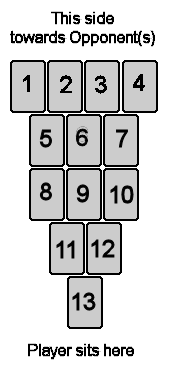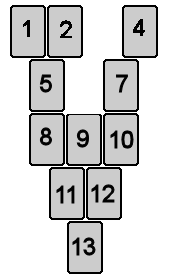Capture the Commander
Contributed by Danny and Isabella Bruggeling
This is a 2-4 player, table-top card game which fuses elements of the games “Memory”, “War”, and “Solitaire.” Players use a combination of strategy and luck to capture their opponent’s “Commander”. Playing time is 5-10 minutes.
A standard 52 card deck used, without Jokers, ranking from 2 (low) up to Ace (high) - but see variations.
Directions
- Shuffle a deck of 52 standard playing cards and deal 13 cards face down to each player. Players do not have to keep the cards in the order they are dealt and can shuffle them. However, players are not to look at their cards.
- Players place their cards in front of themselves in the formation shown below, with card number 13 located closest to them, and cards 1-4 farthest
away from them. Card 5 should touch cards 1 and 2; card 6 should touch cards 2 and 3; card 7 should touch cards 3 and 4. Cards 8, 9, and
10 are located immediately behind 5, 6, and 7. Card 11 touches 8 and 9; Card 12 touches 9 and 10. Card 13 is the player’s “Commander” card which
their opponent(s) will attempt to “capture”. It touches cards 11 and 12. The value of this card, or any of the player’s other cards, should be unknown
to both the player and their opponent(s).

- Players decide who will go first. Play then proceeds clockwise.
- On their turn, the player “attacks” a player of their choice by indicating a “fully uncovered” card in their own set, and either a “fully
uncovered” or “partially uncovered” card of their opponent’s set. (At the beginning of a game, the only cards considered “fully uncovered”
are cards 1-4, and no cards are “partially uncovered”. In the diagram below, where cards 3 and 6 have been removed, 1, 2, 4 and 9 are “fully uncovered” and card 7 is ”partially uncovered”.)

Simultaneously, both players flip over the indicated cards and the higher value card wins the battle. The loser’s card is removed from play and the winning card is flipped back over so that its value is hidden.
Battle Example:
In the above example, Player A indicates they want to use card number 1 from their set to attack card number 2 on Player B’s set. If card 1 is higher than card 2, card 2 is removed from play, partially “uncovering” cards 5 and 6 in Player B’s set. These cards are now open to attack by Player A, but cannot be used by Player B to attack Player A until they are fully “uncovered”. In order for card 5 to be fully “uncovered”, both cards 1 and 2 must be removed. Note: Cards 8, 9, and 10 can only be fully “uncovered”, since they are located directly behind 5, 6, and 7.
If Player A’s attack is unsuccessful, their attacking card (in this case card number 1) is removed from play and Player B’s defending card is flipped back over to hide its value. In the example, if card 1 is removed then card 5 is partially “uncovered” and exposed to attack by an opponent. Player B then takes their turn by indicating one of their fully “uncovered” cards and a fully or partially “uncovered” card on Player A’s set. - Play continues back and forth until one player destroys the other’s card number 13, or “Commander” card.
- If both flipped cards are the same value, then each player chooses a card adjacent to their own attacking or defending card and flips it over.
(A card is considered to be adjacent to another card if it fully or partially “covers” another card, another card fully or partially “covers” it, or it
is directly beside another card.) This continues until a player flips over a higher card than their opponent. All of the loser’s cards that were
involved in the battle are then removed from play. If a player has no more cards to flip over, the side with more cards wins the battle. If both
players have the same amount of cards, the game is considered a draw. - In a 3-4 player game, players try to take out their opponents’ “Commander” cards before their own is destroyed.
Strategy and Tips
Try not to leave any cards partially uncovered, as they are open to attack. Also, once a player can identify where their high cards are located, they can use the same cards repeatedly to attack their opponent(s) when it is their turn, as long as it is still in play. Additionally, it is in one’s best interest to get to the opponent’s number 13 card as quickly as possible, through the shortest possible route.
In order to reach an opponent’s number 13 card, a minimum of four cards must be “destroyed” from the opponent’s set. For example, in order to reach Player B’s “Commander” card in the shortest possible route, Player A must defeat Player B’s 1, 5, 8, 11 cards; or 2, 5, 8, 11; or 2, 6, 9, 11; or 2, 6, 9, 12; or 3, 6, 9, 11; or 3, 6, 9, 12; or 3, 7, 10, 12; or 4, 7, 10, 12.
Variations
Scoring option: For a longer game with scoring, a player who captures a commander gets one point for each of their opponent's cards left at the end of the battle. Play to at least 25 points.
Two vs. Two option: Two players play against two other players. Teammates are allowed to give any previously unflipped card (except for their commander card) to their ally to plug holes and delay their opponents. Once a player's commander has been taken out, the player is out for that round. Teams score 3 points for each captured commander and 1 point for each remaining card after the conclusion of the battle.
Twos beat aces: In the basic game aces are almost invulnerable. They can only be defeated by meeting another ace and losing the resulting war (rule 6), and it is very hard to defeat the lucky player whose commander happens to be an ace. To make aces less powerful, you could agree that when an ace fights a two, the two wins. Two still counts as the lowest card in all other battles.
One suit each: For a game in which the players are more equally matched, give each player one complete suit to shuffle, so that everyone has one of each card from 2 up to ace. This also introduces an extra element of strategy, if you can remember which cards each player has lost and which are still in play.